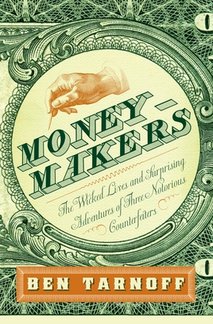
08 Feb 2011 07:48:02
What surprise brings for us the author of the book Ben Tarnoff? What is about this book, and when booklovers may found it on the bookshelves?
Author Ben Tarnoff digs deep into the history of such left-handed pursuits in "Moneymakers: The Wicked Lives and Surprising Adventures of Three Notorious Counterfeiters." While not quite delivering the wickedness and surprises essential to a ripping yarn, Tarnoff provides a colorful tale as he explores the development of American paper money in the 18th and 19th centuries and those who exploited its flaws.
In colonial America, a dearth of gold and silver coins led farmers and laborers to favor paper notes as a medium of exchange. With colonial governments issuing bills of credit, the amoral moneymakers went to work. One particularly successful crook, Owen Sullivan, set up shop in a cave to work in solitude. Those he recruited to pass the worthless paper proved to be the weak links in the counterfeiting chain, and Sullivan often ended up betrayed and on the run.
People caught with worthless paper faced the likelihood that they would be placed in stocks, whipped, lose their ears to the sword and feel the letter "C" branded into their cheeks. In New York, the incorrigible could be sent to the gallows.
By the early 19th century, punishment in the new nation would become less medieval, but the problem of phony money would worsen. Foolish federal and state policies allowed hundreds of different banks to circulate their own paper bills. During what Tarnoff calls a golden age for illicit moneymakers, charming con men like David Lewis could flourish by unloading bogus bills.
Perhaps the most interesting of Tarnoff's trio of moneymakers was, oddly, the most honest. Samuel Curtis Upham was a Philadelphia shopkeeper who began selling Confederate currency as a novelty as the Civil War entered its second year. His so-called mementos of rebellion — wink, wink — not only earned him a good living, they helped to undermine the Confederate economy as they found their way south.
In trying to turn a history of early monetary policy into a narrative, Tarnoff must stretch at times to keep his counterfeiters at the center of the story. He displays a much stronger hand in explaining a past financial world that seems as chaotic and as Byzantine as today's.
Author Ben Tarnoff digs deep into the history of such left-handed pursuits in "Moneymakers: The Wicked Lives and Surprising Adventures of Three Notorious Counterfeiters." While not quite delivering the wickedness and surprises essential to a ripping yarn, Tarnoff provides a colorful tale as he explores the development of American paper money in the 18th and 19th centuries and those who exploited its flaws.
In colonial America, a dearth of gold and silver coins led farmers and laborers to favor paper notes as a medium of exchange. With colonial governments issuing bills of credit, the amoral moneymakers went to work. One particularly successful crook, Owen Sullivan, set up shop in a cave to work in solitude. Those he recruited to pass the worthless paper proved to be the weak links in the counterfeiting chain, and Sullivan often ended up betrayed and on the run.
People caught with worthless paper faced the likelihood that they would be placed in stocks, whipped, lose their ears to the sword and feel the letter "C" branded into their cheeks. In New York, the incorrigible could be sent to the gallows.
By the early 19th century, punishment in the new nation would become less medieval, but the problem of phony money would worsen. Foolish federal and state policies allowed hundreds of different banks to circulate their own paper bills. During what Tarnoff calls a golden age for illicit moneymakers, charming con men like David Lewis could flourish by unloading bogus bills.
Perhaps the most interesting of Tarnoff's trio of moneymakers was, oddly, the most honest. Samuel Curtis Upham was a Philadelphia shopkeeper who began selling Confederate currency as a novelty as the Civil War entered its second year. His so-called mementos of rebellion — wink, wink — not only earned him a good living, they helped to undermine the Confederate economy as they found their way south.
In trying to turn a history of early monetary policy into a narrative, Tarnoff must stretch at times to keep his counterfeiters at the center of the story. He displays a much stronger hand in explaining a past financial world that seems as chaotic and as Byzantine as today's.

